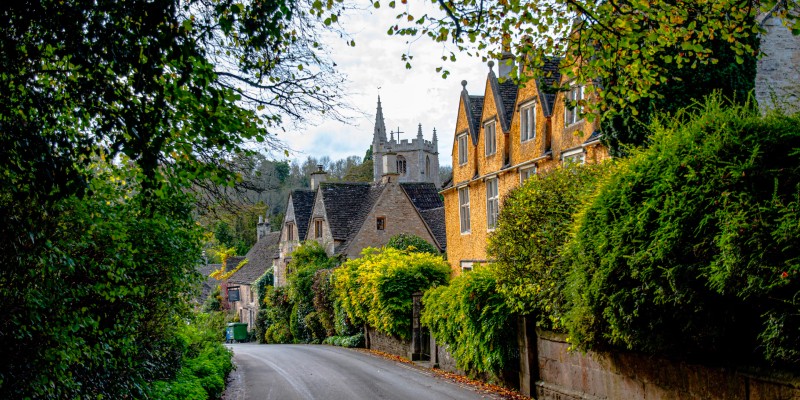A twitching curtain conceals a pair of prying eyes. A friendly smile belies a litany of terrible sins. And eventually, someone is going to find a dead body on their well-manicured lawn.
The small town is a mainstay of cozy mysteries, and for good reason. Readers flock to the genre precisely because of the juxtaposition between violence and placidity. There’s something undeniably compelling about a quaint and wholesome façade that conceals the darkest of human impulses. No matter how grim things get, though, we know that our small town will have returned to its charming self by the end of the book—until the next murder, at least.
In the best mysteries, these towns are the axis around which the entire story spins. Their residents, usually an offbeat and varied bunch, provide a human dimension that brings home the true horror of the evil in their midst. In the hands of gifted storytellers, however, the towns themselves often become characters in their own right, complete with moods, quirks, and histories. While these fictional locales have evolved and changed along with the genre itself, they still retain the mingled eccentricity and intimacy that makes them such wonderful settings for a good mystery. Here are some of my favorites.
Though Agatha Christie certainly wouldn’t have called it “quirky,” the prototypical village of this type is St. Mary Mead, home to the formidable Jane Marple. A lifetime of studying her neighbors has not only provided her with an uncanny intuition about human nature, but also taught her that even the most idyllic of settings can harbor dark and terrible secrets. In Christie’s gleeful recitation of the myriad sins committed by the good people of St. Mary Mead, it’s easy to spot her pointed skepticism about the virtuous and genteel façade of respectable Britishness that she delighted in skewering. Indeed, while reading yet another of Ms. Marple’s tangential anecdotes, one is left to wonder if there’s anyone in her village who isn’t an adulterer, a thief, a murderer, or possibly all three.
Along similar lines is the fictional village of Carsely, home to M.C. Beaton’s amateur sleuth, Agatha Raisin. Nestled in the Cotswolds, Carsely has its share of eccentric residents as well as a surprising number of murders. Unlike Jane Marple, however, Agatha Raisin hasn’t spent her entire life observing the not-so-secret foibles of her charming neighbors—she moves to Carsely from London at the age of 53, drawn there by childhood memories of the Cotswolds and a romanticized imagining of the English countryside. She finds more than she bargained for, however, when she enters the village’s quiche competition and watches the judge drop dead after tasting her entry. Though she’s an outsider, Agatha solves the mystery with the help of some friendly locals, and over the course of future books we watch her become an indispensable part of village life. Carsely exemplifies what we all hope to find in a good cozy mystery: community and belonging, enlivened by the occasional dead body.
Though not a town in the strictest sense of the word, the upscale retirement village of Cooper’s Chase certainly checks all the boxes. Quirky residents? Definitely. Dark secrets? Absolutely. Murder? Repeatedly. Richard Osman’s bestselling Thursday Murder Club series, about a group of senior citizens who band together to solve dastardly crimes, might make the squeamish reconsider their plans to retire to such a community. More than anything, though, Osman’s books celebrate the families that can be found in the most unexpected of circumstances—even if those circumstances involve a few brutal deaths.
As the authorship of cozy mysteries has both deepened and widened, the small and unusual towns at the heart of these stories have become notably more diverse. Mia Manansala’s Tita Rosie’s Kitchen Mysteries, set in Shady Palms, Illinois, is as warmly inclusive as Lila Macapagal’s gossiping Filipino aunties, who offer advice to anyone and everyone whether they asked for it or not. Shady Palms presents an idealized vision of small-town America where different identities and backgrounds coexist in a general harmony disrupted occasionally by sudden and mysterious deaths, and I always love dropping by for a visit.
Themes of family and belonging also lie at the heart of Vivien Chien’s Noodle Shop Mysteries. When Lana Lee returns to the Ho-Lee Noodle House, run by her parents, she finds herself contending with not only their expectations for her, but also the lively and occasionally acrimonious relationships that surround the Asia Village shopping plaza in Cleveland. It makes for a dish as rich and sumptuous as the food described so lovingly by Chien in her books, and it’s this tightly-knit community that keeps me coming back for more.
North of the border, the quintessential Canadian village is Three Pines, home to Chief Inspector Armand Gamache. Author Louise Penny presents this charming Quebecois hamlet as a rustic haven filled with memorable characters who endure the long winters with the help of crackling fires, good wine, and the goodwill of their neighbors. Penny is a masterful storyteller who brings Three Pines to vibrant life, and even when her books take Gamache to other locales, readers know that he’ll always return to the beautiful little town and its cast of colorful residents.
On the other side of the country lies the seaside village of Crescent Cove, the setting for my own debut mystery. Situated on the eastern shore of Vancouver Island and surrounded by stunning natural beauty, this small town harbors some big secrets. As a queer writer, I wanted Crescent Cove to be unabashedly diverse, where all kinds of quirky and interesting people live alongside one another without comment or prejudice. When readers visit my little hamlet on the sea, they’re immersed in a place where everyone is welcome…until they wind up dead, that is.
The towns at the heart of so many cozy mysteries demonstrate both the very best and the very worst of us—our capacity to shape peaceful idylls and also to destroy them from within. It’s their oddities and quirks, however, that transform them from passive backdrops to characters in their own right.
Come for the quaint storefronts, stay for the murder, and visit again soon!
***


















